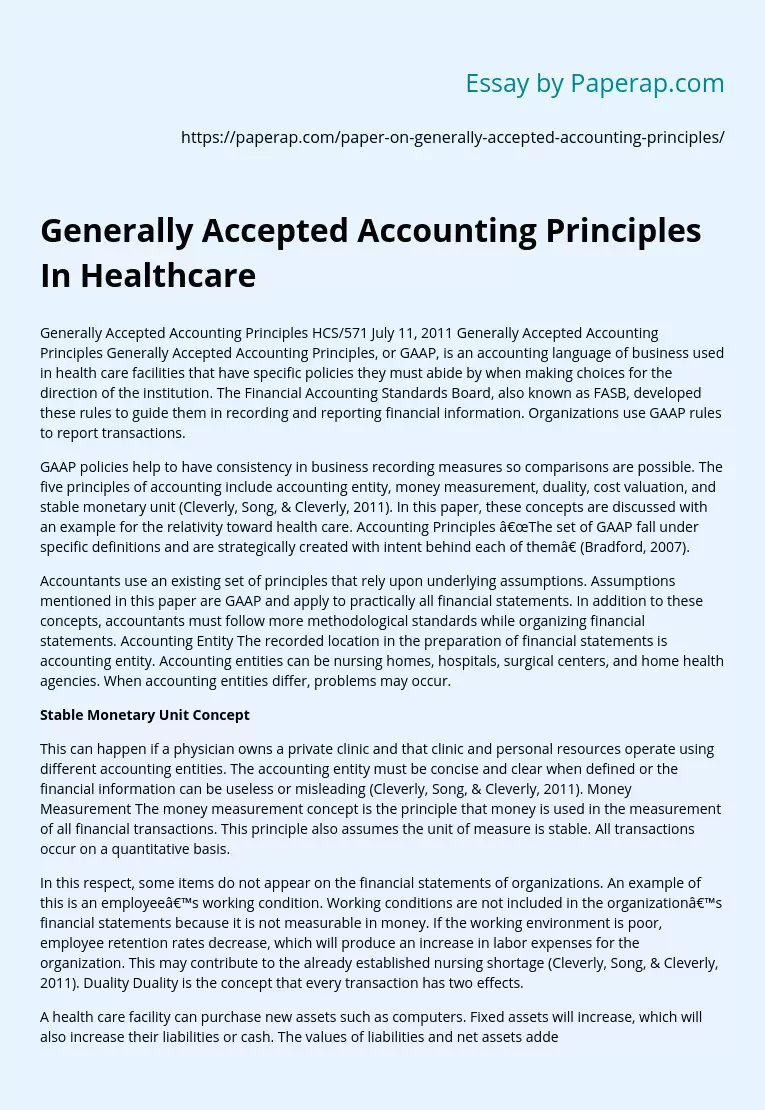Generally Accepted Accounting Principles In Healthcare
Generally Accepted Accounting Principles HCS/571 July 11, 2011 Generally Accepted Accounting Principles Generally Accepted Accounting Principles, or GAAP, is an accounting language of business used in health care facilities that have specific policies they must abide by when making choices for the direction of the institution. The Financial Accounting Standards Board, also known as FASB, developed these rules to guide them in recording and reporting financial information. Organizations use GAAP rules to report transactions.
GAAP policies help to have consistency in business recording measures so comparisons are possible.
The five principles of accounting include accounting entity, money measurement, duality, cost valuation, and stable monetary unit (Cleverly, Song, & Cleverly, 2011).
In this paper, these concepts are discussed with an example for the relativity toward health care. Accounting Principles “The set of GAAP fall under specific definitions and are strategically created with intent behind each of them” (Bradford, 2007).
Accountants use an existing set of principles that rely upon underlying assumptions. Assumptions mentioned in this paper are GAAP and apply to practically all financial statements.
In addition to these concepts, accountants must follow more methodological standards while organizing financial statements. Accounting Entity The recorded location in the preparation of financial statements is accounting entity. Accounting entities can be nursing homes, hospitals, surgical centers, and home health agencies. When accounting entities differ, problems may occur.
Stable Monetary Unit Concept
This can happen if a physician owns a private clinic and that clinic and personal resources operate using different accounting entities. The accounting entity must be concise and clear when defined or the financial information can be useless or misleading (Cleverly, Song, & Cleverly, 2011). Money Measurement The money measurement concept is the principle that money is used in the measurement of all financial transactions. This principle also assumes the unit of measure is stable. All transactions occur on a quantitative basis.
In this respect, some items do not appear on the financial statements of organizations. An example of this is an employee’s working condition. Working conditions are not included in the organization’s financial statements because it is not measurable in money. If the working environment is poor, employee retention rates decrease, which will produce an increase in labor expenses for the organization. This may contribute to the already established nursing shortage (Cleverly, Song, & Cleverly, 2011). Duality Duality is the concept that every transaction has two effects.
A health care facility can purchase new assets such as computers. Fixed assets will increase, which will also increase their liabilities or cash. The values of liabilities and net assets added together equal the value of assets. This equation balances financial sheets all the time. The values in liabilities, net assets, and assets varies in relation to a constantly changing health care world. Health care organizations have a large number of transactions. Hospitals usually categorize their transactions for better uniformity (Cleverly, Song, & Cleverly, 2011). Cost Valuation
Cost valuation is the process of estimating the values of goods. Cost valuations can be done on assets, such as investments, business, enterprises, or intangible assets. Cost valuation is the preferred method for accounts because it is more objective. On financial statements, accountants list the value of assets and liabilities as the value of when they were first purchased. This practice can be misleading because these assets will not equal the amount of money obtained if the assets were sold. Health care organizations use cost valuation to determine the full cost of providing services to clients.
For management to make sound decisions, the full cost must be known at all levels, including department, patient, and procedure (Cleverly, Song, & Cleverly, 2011). Stable Monetary Unit Globalization has help to create accessibility to more people including businesses. Businesses can accept payment for services in several currencies while conducting business around the world. Using the same currency is necessary so accounts remain orderly. Currencies exchanged in the open market hold their stable monetary unit. Inflation and the changing rate of currencies do not take effect.
Accountants do not adjust accounts for inflation so the purchasing power of the dollar is not lost. For example, health care organizations may have a huge cash deficit if their rates are set to historical cost depreciation when it is time for the asset to be replaced. This is why most health care organizations do not use an increased replacement cost in their reports. Accountants report assets as dollar amounts. Balance sheets will not have any assets listed that cannot be reported in dollar amounts (Cleverly, Song, & Cleverly, 2011). Conclusion
GAAP is a collection of standards that allows potential investors to have a dependable view of an institution’s financial status. The above set of principles ensures organizations are consistent with their reporting measures. GAAP has been developing for years and will change with the environment. When individuals understand the basics and significance of financial accountability using GAAP, they understand the procedures and rules that define accepted accounting practice. These general principles need to be applied and practiced in detail.
In addition, these procedures were created to provide standards to measure financial accountability of any organization. Most significantly these principles are the frameworks used to address the specific needs of a health care institution’s financial department. References Bradford, T. (2007, August). An Explanation of Generally Accepted Accounting Principles (GAAP). Accounting by Suite 101. Retrieved from http://www. suite101. com/content/what-is-gaap-a28142 Cleverly, W. O. , Song, P. H. , & Cleverly, J. O. (2011). Essentials of health care finance (7th ed. ). Sudbury, MA: Jones and Bartlett Learning.
Generally Accepted Accounting Principles In Healthcare. (2019, Dec 05). Retrieved from https://paperap.com/paper-on-generally-accepted-accounting-principles/

